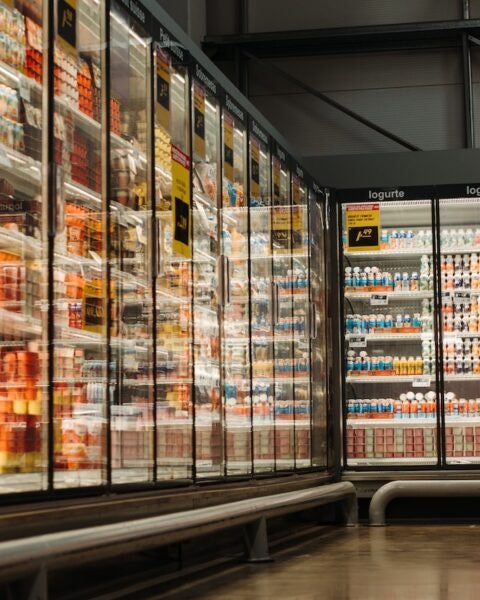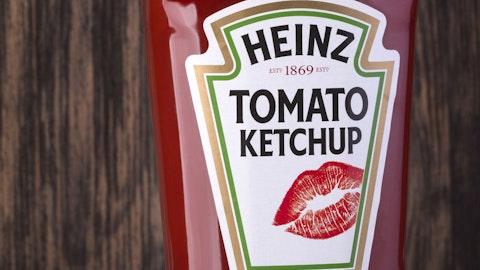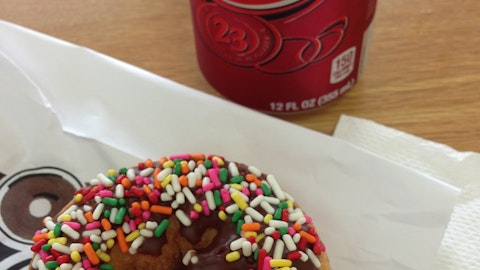Conagra Brands, Inc. (NYSE:CAG) Q3 2023 Earnings Call Transcript April 5, 2023
Operator: Good day, and welcome to the Conagra Brands Third Quarter 2023 Earnings Conference Call. All participants will be in a listen-only mode. Please note today’s event is being recorded. I would now like to turn the conference over to Melissa Napier, Head of Investor Relations. Please go ahead.
Melissa Napier: Good morning. Thanks for joining us for the Conagra Brands’ third quarter and first nine months of fiscal 2023 earnings call. I’m here with Sean Connolly, our CEO; and Dave Marberger, our CFO, who will discuss our business performance. We’ll take your questions when our prepared remarks conclude. On today’s call, we will be making some forward-looking statements. And while we are making these statements in good faith, we do not have any guarantees about the results we will achieve. Descriptions of our risk factors are included in the documents we filed with the SEC. We will also be discussing some non-GAAP financial measures. These non-GAAP and adjusted numbers refer to measures that exclude items management believes impacts the comparability for the period referenced.
Please see the earnings release for additional information on our comparability items. The GAAP to non-GAAP reconciliations can be found in the earnings press release and the slides that we’ll be reviewing on today’s call, both of which can be found in the Investor Relations section of our website. And I’ll now turn the call over to Sean.
Sean Connolly: Thanks, Melissa. Good morning, everyone, and thank you for joining our third quarter fiscal ’23 earnings call. Slide 5 outlines what we’d like you to take away from today’s call. Our top priority coming into fiscal year 2023 was margin recovery following the unprecedented environment of the last two years with COVID and the inflation super cycle. To facilitate that margin recovery, our focus has been on inflation-justified pricing, supply chain improvements and the pruning of low-margin volume, a strategy we have successfully deployed before and refer to as value over volume. And three of the way into the year, our plan is working. In Q3, we delivered our second consecutive quarter of strong gross margin recovery, our pricing execution continued to be excellent while elasticities remain muted and consistent.
Our volume performance again led our near-end peers versus our pre-pandemic baseline and our supply chain continued to improve with service levels exceeding 90%. This improvement allowed us to rebuild inventories to appropriate levels and support most of the strong demand from our customers, but there were exceptions as we experienced temporary manufacturing disruptions in certain categories that prevented us from being in stock. Despite this, we had strong results in the quarter overall, and we are updating our guidance for the year, including increasing our expectations for adjusted EPS growth and tightening the ranges for net sales growth and operating margins. With that overview, let’s dive into the results on Slide 6. We delivered organic net sales of approximately $3.1 billion representing a 6.1% increase over the prior year period.
Our adjusted gross margin of 28.1% represents a 409 basis point increase over the third quarter of last year, and our adjusted operating margin of 16.9% represents a 321 basis point increase over that same period. Adjusted EPS rose 31% from last year to $0.76 per share. The year-to-date results underscore the strength of our performance with growth across all four metrics including 8.1% organic net sales growth compared to the prior year period and the robust margin improvements we set out to achieve at the beginning of the year. Slide 7 shows the sustained recovery of our gross profit margin for a second consecutive quarter. Again, this margin recovery was our top priority for the year. Why? Because our gross margins fund our innovation program, and that innovation has been the centerpiece of our playbook and our success in driving sustained category growth in our two strategic focus areas frozen and snacks.
This recovery, therefore, means you should continue to expect a relentless stream of provocative innovation and brand-building support as we go forward. In fact, looking at Slide 8, you can see that Conagra is one of the only companies in our peer set whose gross margins are essentially on par with pre-pandemic levels. Importantly, our brand strength and innovation pipeline position us well to maintain solid growth and healthy gross margin going forward. As I mentioned at the beginning of the call, our sales growth was primarily driven by inflation justified price increases coupled with ongoing muted elasticities. Slide 9 shows the relationship between elasticities and price increases. As you can see, elasticities have remained remarkably consistent and benign over the last eight quarters, even as we increased the price per unit of our products to help offset ongoing COGS inflation.
And Slide 10 shows our elasticities are among the best in the industry. The modest elasticities, which are well below historic norms and have remained consistent in the face of our inflation justified price increases are a testament to the strength of our brands, the execution of our pricing strategy and the limited impact of private label competition. Turning to Slide 11. As you can see, at the total Conagra level, retail sales grew by 5.5% compared to the third quarter of last year and by 24.7% compared to three years ago. To put some context around the 5.5% number, three points. First, there was a fair amount of noise in the year-over-year comps for the peer set in Q3. Some companies had a very weak year ago period due to supply chain challenges while we had pockets of real strength in the year ago period due to Omicron and strong customer support for products that had recently come off allocation.
Second, we continue to prune low-margin volume, most notably resuming our opportunistic value over volume strategy on select brands. This included eliminating 10 for 10 promotions on both value tier vegetables and canned products such as Chef Boyardee and Hunt’s Tomatoes. Third, we experienced manufacturing disruptions in certain categories that led to out of stocks in the quarter. Most notably impacted where our canned meals and sides businesses, specifically canned pasta, canned beans, canned chili and canned meat, all part of our grocery portfolio. In Frozen, we had one noteworthy disruption as our fish business was on allocation, which led to out of stocks during the peak Lenten season. This was due to a fire on our fish frying line as reported in our second quarter 10-Q.
While these discrete issues suppressed our volume in Q3, the root causes have been largely resolved, and we expect volumes to rebound sequentially from here. Importantly, when you take the noise out of the short-term view and compare our growth versus the stable baseline of three years ago, you see our performance has been strong on both the top and bottom lines. Dampening the results versus this time period normalizes for the volatility across demand, inflation and supply chain throughout the pandemic and demonstrates that Conagra is a top performer among our peer set. Slide 12 details our top line performance on a three-year basis as measured over the prior 52 weeks and compared to our near-end peer group who are footnoted in alphabetical order at the bottom of the slide.
Among this group, Conagra continued to rank second in dollar sales growth and first in unit sales performance just as we did in Q2. This remains true when you look at the same chart isolating the third quarter. And post-Q3, the syndicated scanner data has shown our unit sales trends improving. In fact, in the four-week period ending 3/25 are units ranked in the middle of our near-end peer group on a two-year CAGR basis. Our continued top-tier pricing execution and volume performance is made possible by the strength of our brands and the superior relative value that our products provide to the consumer. Let’s take a look at our top line performance during the third quarter by retail domain, starting with Frozen on Slide 14. We maintained our momentum, delivering strong retail sales growth on both a one- and three-year basis, improving 4% and 23%, respectively.

Photo by Eduardo Soares on Unsplash
This growth was driven by a number of our key categories, including breakfast sausages and single-serve meals. It’s worth noting that this performance comes on top of very strong performance for our frozen domain in the year ago period when the Omicron outbreak influenced consumers’ in-home eating behavior. For example, single-serve deals grew 12% last year, creating a two-year stack of 18% in that category. Turning to Snacks on Slide 15. You can see a similar story. We drove a 7% increase in retail sales compared to the third quarter of fiscal ’22 and a 39% increase over the third quarter of fiscal ’20. The continued momentum in this domain is broad-based across a number of categories. Compared to last year, seeds was up over 22% and baking mixes and microwave popcorn both rose more than 10%.
Meat snacks grew 6% year-over-year, building on top of the 22% growth in the year ago quarter, a period when meat snacks were coming off allocation and our customers were eager to fulfill demand for our leading products in this category. We also continued to drive growth in our highly relevant staples portfolio despite the discrete supply chain challenges in some of our canned meals and sides businesses that I noted earlier. Our staples portfolio increased retail sales 7% compared to the third quarter of last year and 20% compared to the same period three years ago. This growth was led by WIP toppings, which grew more than 18% on a year-over-year basis. Turning to Slide 17. While we experienced transitory supply chain friction, we also continue to make progress on our supply chain initiatives during the third quarter, which benefited from continued headway on our ongoing productivity initiatives, which remain on track to achieve the targets we outlined at our most recent Investor Day, and more moderate increases in COGS as anticipated.
These improvements to our supply chain led to improvements in the service we provide our customers. While we’re making good progress in supply chain, it’s not back to normal and industry-wide challenges persist. However, we’re recovering as expected, and we see more room for improvement as we advance our productivity initiatives, and the macro environment continues to normalize. Overall, we’re confident we will deliver on our top line and margin guidance for the year, and we’re raising our bottom line estimates. With that in mind, we are updating our guidance to reflect that we now expect organic net sales growth of 7% to 7.5%. We expect adjusted operating margin of 15.5% to 15.6%, and we’re increasing our expectations for adjusted EPS growth to range from $2.70 to $2.75.
Before I hand the call over to Dave, I want to reiterate our confidence in the path ahead. We have successfully executed pricing actions in response to inflation, that inflation is moderating, and elasticities remain remarkably consistent and benign. We’re moving past discrete supply chain disruptions and continue to make progress on our margin expansion initiatives such as productivity and value over volume, all within an environment that is normalizing. And as we look at more recent scanner data, we are already seeing improvements in sales trends and we expect that momentum to accelerate through the end of the fiscal year. Overall, Conagra continues to benefit from strong brands, strong processes and strong people, which are all working together to drive sustainable growth and margin expansion.
With that, I’ll pass the call over to Dave to cover the financials from the quarter in more detail.
Dave Marberger: Thanks, Sean, and good morning, everyone. I’ll begin by discussing a few highlights as shown on Slide 20. We delivered another quarter of strong results, reflecting the ongoing strength of our brands and successful execution of the Conagra Way playbook. In the quarter, organic net sales increased 6.1% due to inflation-justified pricing and continued muted elasticities, as Sean discussed. Adjusted gross margin increased 409 basis points to 28.1%, and adjusted gross profit dollar growth was up 23.9% for Q3 and 17.8% year-to-date benefiting from higher organic net sales and productivity initiatives, reflecting our focus on margin recovery. This increase in adjusted gross profit contributed to strong adjusted EBITDA growth of 21.1% in the quarter.
Let me breakdown the drivers of our 6.1% organic net sales growth here on Slide 21. We delivered 15.1% improvement in price/mix from our inflation-justified pricing actions. This price improvement was partially offset by a 9% decrease in volume. If you simply apply Conagra’s current and historically favorable 0.54 elasticity factor to the 15.1% price/mix, you will see that elasticity explains approximately eight of the nine percentage points of the volume decline. The remaining one percentage point volume decline is mostly from the supply chain disruptions we’ve discussed. And given our elasticities have been running at these favorable levels for some time now, this level of volume decline has been planned in our fiscal ’23 sales and gross margin projections.
Slide 22 shows the top line performance for each segment in Q3. We are pleased with the continued net sales growth across all four reporting segments. Our domestic retail portfolio continues to perform well. With net sales in our Grocery & Snacks and Refrigerated & Frozen segments, up a combined 4.7%. Our International segment saw solid growth in the quarter with organic net sales up 9.5%. International reported net sales were up 7.7%, reflecting the unfavorable impact of foreign exchange. Finally, we continued to see strong recovery in our Foodservice segment, which grew 17.3% in the quarter. I’d now like to discuss our Q3 adjusted margin bridge found on Slide 23. As Sean discussed, we are pleased to have delivered a second consecutive quarter of strong margin recovery.
We drove a 10.9% margin benefit from improved price/mix during the quarter and realized a 1.8% benefit from continued progress on our supply chain productivity initiatives. These pricing and productivity benefits were partially offset by continued inflationary pressure with 8% gross market inflation impacting our operating margins by 5.9% and a negative impact of 2.8% from market-based sourcing. Finally, higher investment in A&P and adjusted SG&A during the quarter reduced margins by 0.4% and 0.5%, respectively. Slide 24 breaks down our adjusted operating profit and margin by segment. While some supply chain challenges continued during the quarter, execution of pricing and improvements in our productivity and service levels allowed us to deliver adjusted operating margin expansion in each segment.
Total adjusted operating profit increased 30.8% to $522 million during the quarter despite an increase in adjusted corporate expense primarily due to increased incentive compensation. It is worth noting that we delivered 321 basis points of adjusted operating margin improvement in Q3 versus a year ago, while incurring incremental transitory costs in our Grocery & Snacks segment due to the supply chain challenges we’ve discussed. Turning to Slide 25. Our Q3 adjusted EPS increased by 31% or $0.18 per share compared to a year ago primarily driven by higher sales and gross profit as well as from a small benefit in taxes. Our Ardent Mills joint venture performance continued to be strong and has wrapped strong results from a year ago. These positives were partially offset by higher adjusted A&P and SG&A as well as lower pension and post-retirement income and higher interest expense versus a year ago.
You can see on Slide 26, how we are continuing to strengthen our balance sheet metrics. At the end of the third quarter, our net leverage ratio was 3.65x, down from 4.2x at the prior year period. Our net cash flow from operating activities reflects investment to rebuild our inventory levels. Improvement in our inventories has enabled us to improve service levels above 90%, and we are well positioned going forward in most categories to support sustained demand. Year-to-date CapEx was $267 million at the end of the quarter, down from $364 million in the prior year period, while year-to-date free cash flow increased to $436 million. We remain committed to returning capital to shareholders as evidenced by the year-to-date increase in our dividend payments and share repurchases.
For the balance of fiscal ’23, we will continue to evaluate the highest and best use of capital to strengthen our balance sheet and optimize shareholder value. As Sean mentioned, in response to our continued business momentum and ongoing operating dynamics, we are raising our fiscal ’23 EPS guidance and narrowing our ranges for organic net sales growth and adjusted operating margin with only one quarter remaining in fiscal ’23. Turning to Slide 28. I’d like to briefly discuss the considerations and assumptions behind our guidance. We continue to expect total gross inflation of approximately 10% for fiscal ’23 and expect gross inflation to continue for the full calendar year 2023. We will update you at our Q4 earnings call in July with our inflation expectations for full year fiscal ’24.
We expect our net leverage ratio at year-end to remain approximately 3.65x and anticipate CapEx spend of approximately $370 million for fiscal ’23. This number is below our original expectations due to the timing of certain projects. We remain committed to making capital investments to support our growth and productivity priorities with a focus on capacity expansion and automation. Lastly, we expect interest expense to be approximately $410 million and pension and post-retirement income to be approximately $25 million for the year, driven by the higher interest rate environment. Our full year tax rate estimate remains approximately 24%. To sum things up, we are proud that we delivered another strong quarter in fiscal ’23 especially considering a supply chain environment that continued to present some challenges.
Our service levels have improved and our margins continue to recover to pre-COVID levels, and we remain committed to executing on our strategic priorities to generate value for our shareholders. That concludes our prepared remarks for today’s call. Thank you for listening. I’ll now pass it back to the operator to open the line for questions.
See also 15 Most Powerful Countries in Asia in 2023 and Cathie Wood’s Stock Portfolio: 2023 Stock Picks.
Q&A Session
Follow Conagra Brands Inc. (NYSE:CAG)
Follow Conagra Brands Inc. (NYSE:CAG)
Operator: Thank you. We will now begin the question-and-answer session. Today’s first question comes from Andrew Lazar with Barclays. Please go ahead.
Andrew Lazar: Sean, maybe to start off with something a little bit broader. I think we’re all aware of what the more sort of negative narrative on the overall food group is at this stage, which is as food companies lap the pricing and organic sales will slow, companies will raise promotions to drive volume, and that will somehow compete away the margin recovery. And I guess I was hoping that in light of Conagra’s results today and sort of the implicit fourth quarter EPS that looks to be a bit below the current street view. I guess I’m curious, how would you characterize your results sort of in the context of the group-wide narrative that I sort of just laid out?
Sean Connolly: As I’ve said on these calls many times before, navigating these inflation cycles is pretty mechanical. You get hit with inflation, you take price, you don’t reflect it right away, and therefore, you experience a lag, which compresses margins, but then pricing catches up and margins recover as you saw us start to do really materially in Q2. Then when you wrap these actions, dollar growth comes down and unit performance improves, both because elasticities wane and because you wrap the unit impact. So that stuff is all mechanical, and it’s all predictable. I think what you’re getting at is the big question then becomes what comes next. And the goal is obviously sustained growth. And the debate that you’re poking at here is, well, what will the tactic be?
And to me, that answer is crystal clear, especially for us, simply by looking at how we have pursued growth since I have been with Conagra. The answer in a word is innovation. Just look at our frozen performance it was 100% about innovation, premiumization, but ironically, also value over volume philosophy around actually eliminating low-quality promotion. So the question then becomes, why would Conagra suddenly or anybody else for that matter, suddenly believe that the opposite approach is now a smart growth strategy? That doesn’t make a lot of sense to me. As far as, as Q4 goes, first, listen, as I said in my opening remarks, I feel very good about where we sit and our plan is working. Our margin recovery is in place, our elasticities remain benign and consistent, supply chain is improving, innovation is hitting the market, top line trends are improving.
So in terms of the implied Q4 guide, we think it’s prudent. Supply chain is improving but it’s not all the way back, and our position all year has been to plan conservatively in this regard. And as far as unit volume goes, I think we gave you a lot of color on that already. But for those that are more inclined to focus on short-term trends, our eight-year unit CAGR in the most recent four-week period scanner data, which is ending 3 25 was right smack in the middle of our peer set and at levels that are entirely predictable as our muted elasticities kind of show you. So to be above that, either elasticities would have to be nonexistent or you would have to be shipping ahead of consumption. And the former is unrealistic, and the latter is not part of our playbook.
Andrew Lazar: Right. Great. And then just I didn’t hear — just a quick one. I didn’t hear any mention of the canned meat recall as impacting the quarter. And I’m pretty sure there was supposed to be some impact but maybe I got that wrong. And then I’ll pass it on.





